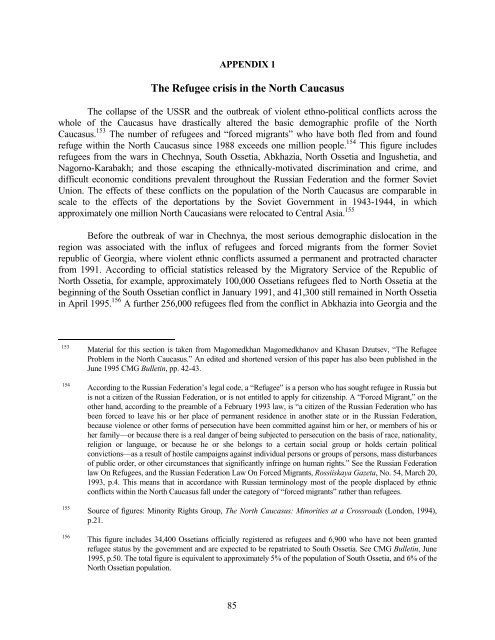RUSSIA'S TINDERBOX - Belfer Center for Science and International ...
RUSSIA'S TINDERBOX - Belfer Center for Science and International ...
RUSSIA'S TINDERBOX - Belfer Center for Science and International ...
You also want an ePaper? Increase the reach of your titles
YUMPU automatically turns print PDFs into web optimized ePapers that Google loves.
APPENDIX 1<br />
The Refugee crisis in the North Caucasus<br />
The collapse of the USSR <strong>and</strong> the outbreak of violent ethno-political conflicts across the<br />
whole of the Caucasus have drastically altered the basic demographic profile of the North<br />
Caucasus. 153 The number of refugees <strong>and</strong> “<strong>for</strong>ced migrants” who have both fled from <strong>and</strong> found<br />
refuge within the North Caucasus since 1988 exceeds one million people. 154 This figure includes<br />
refugees from the wars in Chechnya, South Ossetia, Abkhazia, North Ossetia <strong>and</strong> Ingushetia, <strong>and</strong><br />
Nagorno-Karabakh; <strong>and</strong> those escaping the ethnically-motivated discrimination <strong>and</strong> crime, <strong>and</strong><br />
difficult economic conditions prevalent throughout the Russian Federation <strong>and</strong> the <strong>for</strong>mer Soviet<br />
Union. The effects of these conflicts on the population of the North Caucasus are comparable in<br />
scale to the effects of the deportations by the Soviet Government in 1943-1944, in which<br />
approximately one million North Caucasians were relocated to Central Asia. 155<br />
Be<strong>for</strong>e the outbreak of war in Chechnya, the most serious demographic dislocation in the<br />
region was associated with the influx of refugees <strong>and</strong> <strong>for</strong>ced migrants from the <strong>for</strong>mer Soviet<br />
republic of Georgia, where violent ethnic conflicts assumed a permanent <strong>and</strong> protracted character<br />
from 1991. According to official statistics released by the Migratory Service of the Republic of<br />
North Ossetia, <strong>for</strong> example, approximately 100,000 Ossetians refugees fled to North Ossetia at the<br />
beginning of the South Ossetian conflict in January 1991, <strong>and</strong> 41,300 still remained in North Ossetia<br />
in April 1995. 156 A further 256,000 refugees fled from the conflict in Abkhazia into Georgia <strong>and</strong> the<br />
153 Material <strong>for</strong> this section is taken from Magomedkhan Magomedkhanov <strong>and</strong> Khasan Dzutsev, “The Refugee<br />
Problem in the North Caucasus.” An edited <strong>and</strong> shortened version of this paper has also been published in the<br />
June 1995 CMG Bulletin, pp. 42-43.<br />
154 According to the Russian Federation’s legal code, a “Refugee” is a person who has sought refugee in Russia but<br />
is not a citizen of the Russian Federation, or is not entitled to apply <strong>for</strong> citizenship. A “Forced Migrant,” on the<br />
other h<strong>and</strong>, according to the preamble of a February 1993 law, is “a citizen of the Russian Federation who has<br />
been <strong>for</strong>ced to leave his or her place of permanent residence in another state or in the Russian Federation,<br />
because violence or other <strong>for</strong>ms of persecution have been committed against him or her, or members of his or<br />
her family––or because there is a real danger of being subjected to persecution on the basis of race, nationality,<br />
religion or language, or because he or she belongs to a certain social group or holds certain political<br />
convictions––as a result of hostile campaigns against individual persons or groups of persons, mass disturbances<br />
of public order, or other circumstances that significantly infringe on human rights.” See the Russian Federation<br />
law On Refugees, <strong>and</strong> the Russian Federation Law On Forced Migrants, Rossiiskaya Gazeta, No. 54, March 20,<br />
1993, p.4. This means that in accordance with Russian terminology most of the people displaced by ethnic<br />
conflicts within the North Caucasus fall under the category of “<strong>for</strong>ced migrants” rather than refugees.<br />
155 Source of figures: Minority Rights Group, The North Caucasus: Minorities at a Crossroads (London, 1994),<br />
p.21.<br />
156 This figure includes 34,400 Ossetians officially registered as refugees <strong>and</strong> 6,900 who have not been granted<br />
refugee status by the government <strong>and</strong> are expected to be repatriated to South Ossetia. See CMG Bulletin, June<br />
1995, p.50. The total figure is equivalent to approximately 5% of the population of South Ossetia, <strong>and</strong> 6% of the<br />
North Ossetian population.<br />
85
















